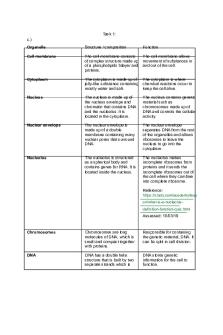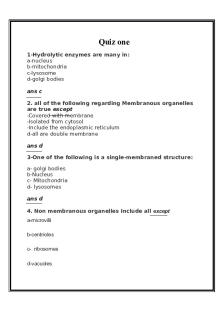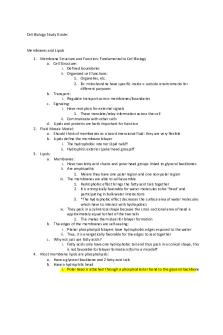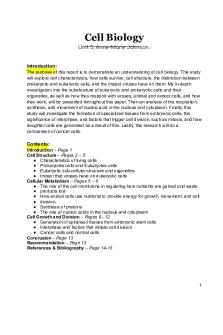Chapter 18.3 Key for Cell Biology 341 PDF

| Title | Chapter 18.3 Key for Cell Biology 341 |
|---|---|
| Course | Cell Biology |
| Institution | University of North Dakota |
| Pages | 2 |
| File Size | 68.6 KB |
| File Type | |
| Total Downloads | 106 |
| Total Views | 134 |
Summary
Chapter 18.3Quiz Key for Cell Biology with Dr. Sally Pyle. Has correct questions and answers. ...
Description
Biol 341: Ch 18.3 Learning Activity 4-24 KEY
Group # __________
Manager ___________________ Recorder ___________________ Skeptic ___________________ 1. (3 points) Give three reasons why apoptosis, a form of programmed cell death, is a good thing for animals. --cells dying by apoptosis don’t trigger inflammation, such as caused by necrosis --apoptosis can prevent damaged cells from dividing and becoming cancerous --important role in development, e.g.: loss of tail in tadpoles, formation of fingers in humans, etc. --removal of unneeded white blood cells (lymphocytes) when no longer needed after infections, etc. --cells infected with viruses can undergo apoptosis, therefore viruses don’t have chance to replicate 2. (5 points) For each of the following say whether it would increase the likelihood of cell death or survival of a neuron. Briefly explain your answer. a. Increase in BAX levels increase cell death, as BAX is an apoptosis promoter (by helping form pores that allow cytochrome C into cytosol from mitochondria) b. Release of cytochrome C into cytosol increase cell death, Cytochrome C in the cytosol can activate apoptosomes, which lead to activation of caspases and apoptosis c. Overexpression of Bcl-2 increase cell survival: Bcl-2 is an apoptosis inhibitor, which works through inhibiting proteins like BAX…. d. Treatment with a growth factor such as NGF increase cell survival: NGF works as a survival factor by increasing levels of Bcl-2, which inhibits apoptosis e. Cleavage of pro-domain from procaspase increase cell death: removal of the pro-domain by proteolysis causes caspases to become activated, which leads to apoptosis
3. (1 point) Describe the role of microtubules during animal and plant cytokinesis. Both plant and animal cells use interpolar microtubules as part of their mitotic spindle apparatus. During cytokinesis in animals the interpolar microtubules direct the actin/myosin to the mid-point of the cell to begin cytokinesis, and the interpolar microtubules assure that the cytoplasm and organelles is are divided equally between the 2 daughter cells. In plants the interpolar microtubules define the mid-point of the dividing cell and direct Golgi vesicles, containing cell wall material surrounded by cell membrane, to the center of the dividing cell. The Golgi vesicles fuse and form the phragmoplast that will eventually form the cell membranes and cell walls between the 2 daughter cells.
4. (1 point) One hypothesis for why people age is that progressively more reactive oxygen species (ROS) are generated in mitochondria, and this leads to damage to DNA, proteins and lipids. Explain why oxidative damage to mitochondria membranes, possibly making them leaky, would result in the initiation of apoptosis. if mitochondrial membranes become damaged, cytochrome C can leak out. Cytochrome C binding to a complex results in procaspases becoming activated and beginning caspase cascade leading to apoptosis (as caspases get activated, apoptosis is triggered)...
Similar Free PDFs

Cell biology
- 3 Pages

Cell Biology Quiz CELL ORGANELLES
- 10 Pages

Cell Biology Study Guide
- 37 Pages

Cell Biology unit (5)
- 14 Pages

Cell Biology Syllabus 2019
- 5 Pages

Apoptosis - Summary Cell Biology
- 4 Pages

Cell biology exam, answers
- 11 Pages

Cell biology lecture notes
- 108 Pages

Adam\'s Cell Biology- Exocytosis
- 4 Pages

Cell biology and genetics
- 12 Pages

Cell biology revision notes
- 5 Pages

Unit 5 Cell Biology
- 18 Pages
Popular Institutions
- Tinajero National High School - Annex
- Politeknik Caltex Riau
- Yokohama City University
- SGT University
- University of Al-Qadisiyah
- Divine Word College of Vigan
- Techniek College Rotterdam
- Universidade de Santiago
- Universiti Teknologi MARA Cawangan Johor Kampus Pasir Gudang
- Poltekkes Kemenkes Yogyakarta
- Baguio City National High School
- Colegio san marcos
- preparatoria uno
- Centro de Bachillerato Tecnológico Industrial y de Servicios No. 107
- Dalian Maritime University
- Quang Trung Secondary School
- Colegio Tecnológico en Informática
- Corporación Regional de Educación Superior
- Grupo CEDVA
- Dar Al Uloom University
- Centro de Estudios Preuniversitarios de la Universidad Nacional de Ingeniería
- 上智大学
- Aakash International School, Nuna Majara
- San Felipe Neri Catholic School
- Kang Chiao International School - New Taipei City
- Misamis Occidental National High School
- Institución Educativa Escuela Normal Juan Ladrilleros
- Kolehiyo ng Pantukan
- Batanes State College
- Instituto Continental
- Sekolah Menengah Kejuruan Kesehatan Kaltara (Tarakan)
- Colegio de La Inmaculada Concepcion - Cebu



